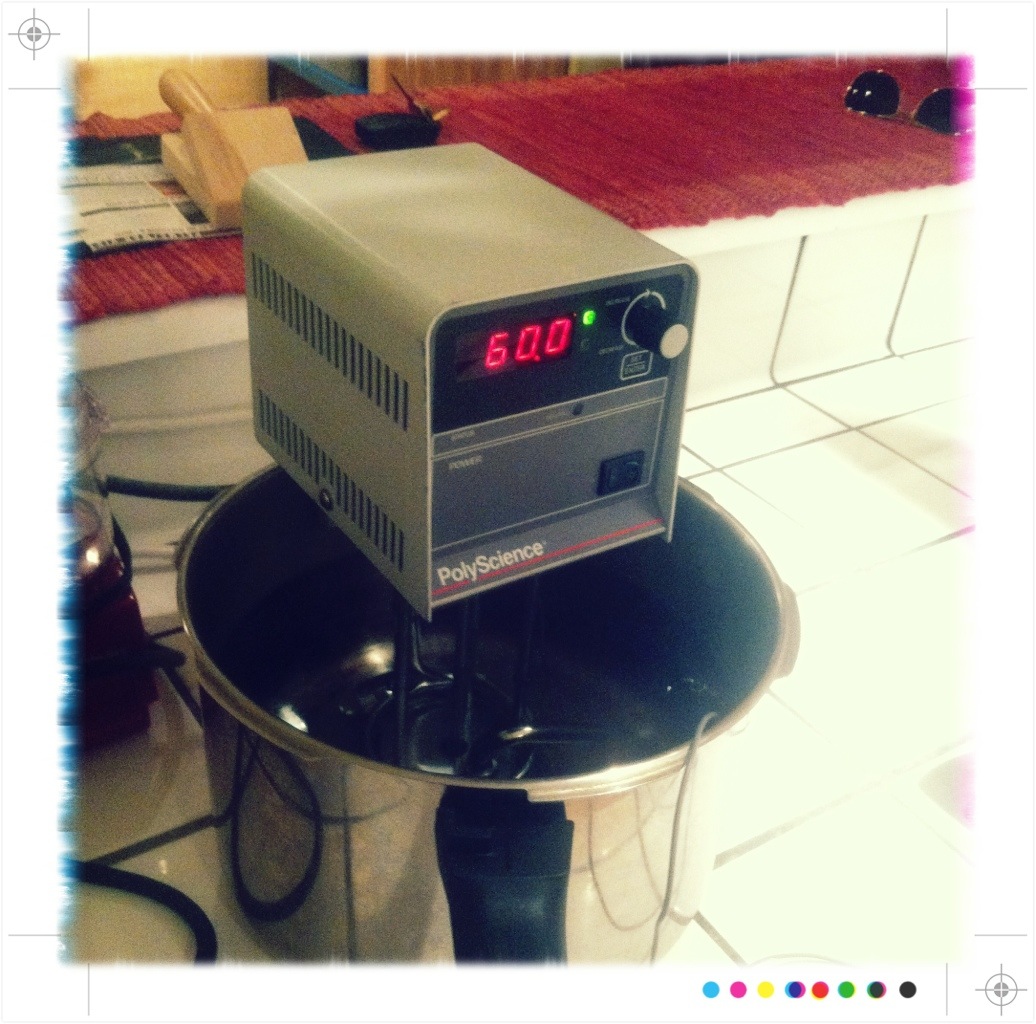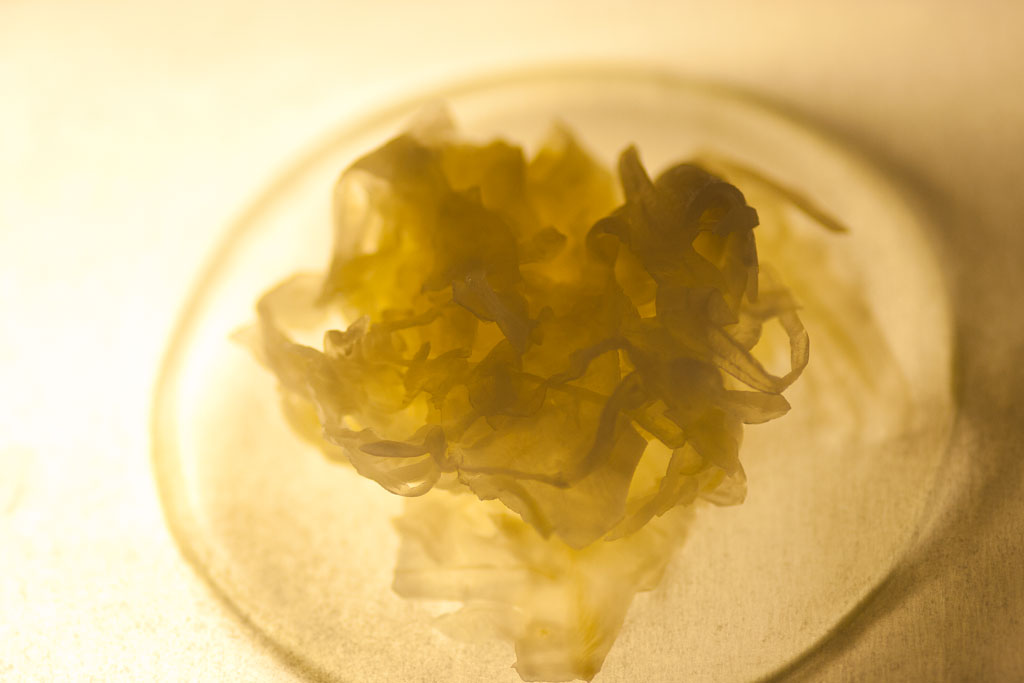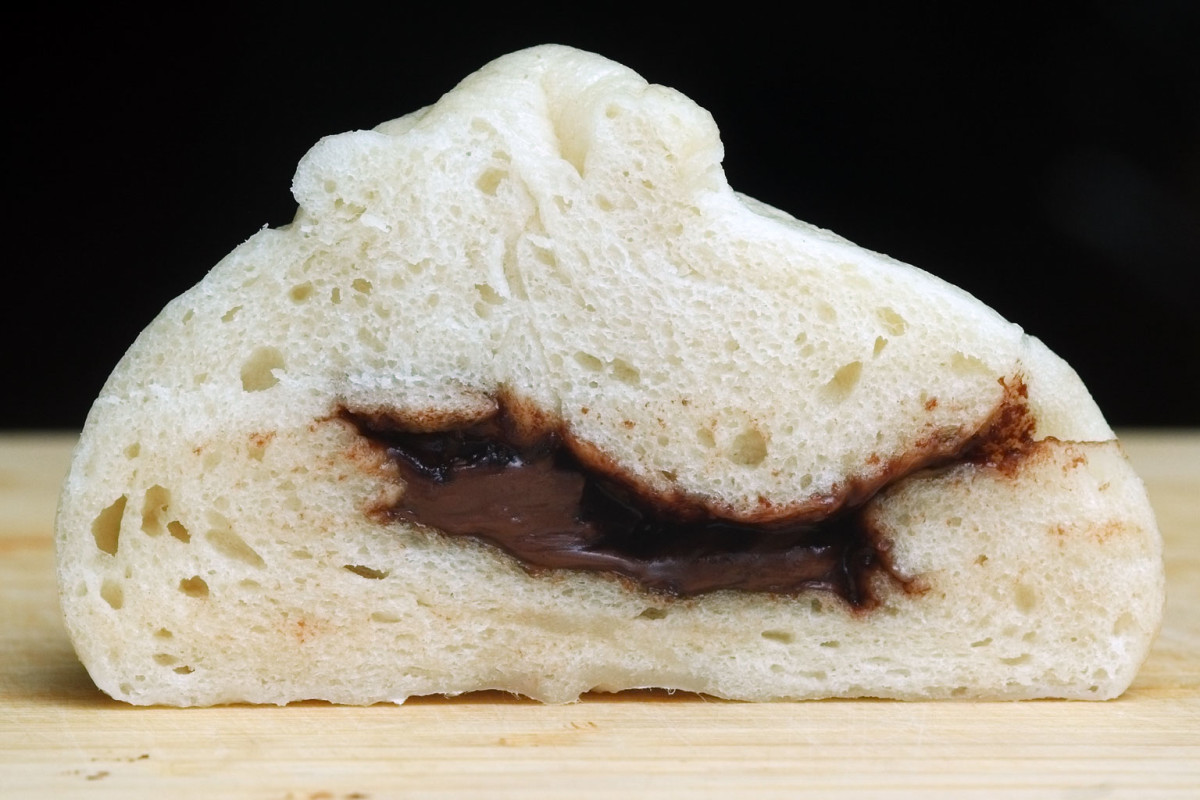And more on eggs… I don’t think there’s any other ingredient I find as fascinating as eggs. In my previous post on homemade mayo/aioli, I talked about an incredibly easy way to get the emulsion going with the help of a hand blender then I wondered how many people out there could be concerned with eating raw eggs. Although I’ve never gotten sick (knock on wood!) it does happen, and salmonella could send even the fittest individual right to the hospital. There are options, especially here in the US, where buying pasteurized eggs is a possibility. They can be pricey but the cost/benefit, in this case, makes sense. There is another way to pasteurize eggs.
With the help of an immersion circulator is dead simple, but it can be done with an inexpensive probe thermometer and a big pot filled with water as well. The idea behind pasteurization is simple. Heat something to a specific temperature by a specific length of time and eventually pathogens die. The lower the temperature, the less the targeted product will change state (phase) or flavor. In the case of an egg, we want to kill the bacteria but we don’t want to cook the egg. It is a well-documented fact what different temperature does to an egg. It is also a well-documented fact what temperature is required to kill the salmonella bacteria. Here’s is a little excerpt from the wikipedia entry on salmonella:
“Salmonella bacteria can survive for weeks outside a living body, and they are not destroyed by freezing. Ultraviolet radiation and heat accelerate their demise; they perish after being heated to 55 °C (131 °F) for 90 min, or to 60 °C (140 °F) for 12 min. To protect against Salmonella infection, heating food for at least ten minutes at 75 °C (167 °F) is recommended, so the centre of the food reaches this temperature.”
To play it extra safe let’s do 57 °C (134.6 °F) for 2 hours which is well within the safety range stated above. Not only will salmonella be destroyed but all other pathogens present as well. Win win.

Notice how the white has gone slightly cloudy. My immersion circulator has been operating with a 0.1 degree over the target temperature, maybe that contributed to the cloudiness and the fact that extended periods of time will continue to slowly denature proteins even at such slow temperatures.

Improvising a sous vide water bath at home isn’t difficult. You do need a thermometer, preferably one with a probe so you can throw it in the pot and forget about it (I wouldn’t let it reach or be to close to the bottom, try suspending it in the middle of the water volume) Start with hot tap water (to save some time) and heat up the pot on medium heat. Checking the temperature and stirring the water. When the temperature reaches 134.6 °F set the stove to the lowest setting. It will be impossible to maintain the water at an exact temperature but some over or undershooting is ok, as long as you don’t go near the temperatures at which the egg will cook. Some practice will be required, just to get familiar with the stove and how fast water heats up and cools off.


Since I’ve made mayo, I figured I could use the same idea and pasteurize my mayo as well. The same principle applies and makes making mayo at home extremely convenient as safe. With the addition of yogurt, the shelf life of homemade mayo can be extended from a few days to a couple of months. Vinegar also helps keep pathogens under control.

I added my aioli to a sealable baggie and sucked the air out of it using my vacuum chamber sealer. Not all that necessary though. Since we’re pasteurizing a liquid, we could place the mayo in jars, make sure to tighten the lid well and submerge the jars in the water placing an object over them to keep them submerged. If using the improvised sous vide bath, don’t place the jars directly onto the bottom of the pot which is the hottest, the mayo could be cold and the jars could crack. To prevent air pockets in the jars, you could cover the mayo with vegetable oil, which you could drain afterward.

Place the baggies in the water bath for the required time and done. The Mayo didn’t separate. Once done, you can store your pasteurized eggs or mayo back in the fridge!


Hope you find this useful!!! Thank you for stopping by! Safe egg eating! I hope you feel more encouraged to trying making mayo at home even without having pasteurized eggs at hand. Take care!
Wanna get more sous-vide cooking guides and cool cooking how-to’s in your mailbox? You know what needs to be done!
We never spam. You should only be getting updates when new content is posted on the site. We also respect your privacy. We don’t share your email address with anyone and you can unsubscribe anytime!





17 comments
Interesting reading, thanks for the tip!
I’ve been wanting to do a post on pasteurizing for a long time… but for some reason or another I post pone. Until now! I’m glad you liked it! thank you!
My my look at the egg yolk oozing out beautifully! I’m a huge egg fan, this post is very useful indeed! Thank you.
Really glad you found it useful Phuong! and thank you!
That is very impressive. And a fascinating read. Thank you!
I love that kind of stuff! welcome!
relinking thoughts
For your long storage mayo, how much yogurt do you add, and do you add it before or after pasteurising?
hi Peggy! The quantity isn’t that important. A small amount will inoculate the mayo with nice lacto fermenting bacteria which is what you want. The bacteria will reproduce and acidify your mayo further (lactic acid). Use active cultured yogurt (not pasteurized) and use about a tbsp or so after you’ve pasteurized the mayo. Not before. That would kill the good lacto fermenting bacteria that comes with the yogurt. Hope this helps!
I just got a new Instant Pot “Ultra” which has a sous vide option, so I am reading up on it and ran across your article here. Since I make my own mayo, I am excited at the prospect of pasteurizing my own eggs. (I only use the yolks as I am sensitive to the whites, if that makes any difference). If I don’t use it all, it goes off within a few days, so I’d like to know how long do you estimate this mayo will last…and would the mayo last longer pasteurizing the whole mayo after it’s made vs just the egg?
I’ve been wondering about those instant pots! a friend of mine has one and he loves it. To answer your question… how long does home un-pasteurized mayo last? I don’t know, about a week or so in the fridge I would guess. The difference between pasteurizing mayo vs just the eggs… pasteurizing mayo is probably a safer bet since you’re reducing bacteria for the entire product not just one ingredient.
So, do the same time and temp work for the mayo as well as the eggs?
yes, it really doesn’t matter what it is. The process would kill pathogens in any food 🙂